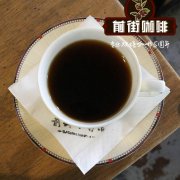Latte without milk? What on earth is a latte latte?
First of all, let's take a minute to learn about latte Latte.
In China, when you order a latte, Chinese baristas will default that you make a coffee latte, and some customers will order a matcha latte, but there is not a drop of coffee in it.

Yes, dear, the matcha latte doesn't contain any coffee at all.
Latte formerly known as latte, literally means milk, matcha latte is actually matcha-flavored milk. If you are in Italy, Spain and other countries, you ask for another latte, and the barista will definitely bring you a cup of milk.
At present, many cafes such as matcha lattes, black tea lattes, pumpkin lattes, red velvet lattes do not contain a drop of coffee, and many Korean cafes sell hot cereal lattes, all without coffee.
Latte, of course, is coffee, latte (one cup of 200ml): one espresso with 1 shot 30 ml + milk

Baristas, there are always some customers who don't follow the routine.
There will always be.
For example, every barista will encounter:
"my macchiato doesn't want milk."
"A latte requires no milk."
"have an American style and pull a flower."
"order a cup of decaf coffee."
"your coffee doesn't smell like Starbucks."
Then if the guest orders, "give me a latte, no milk!" "well, does he order espresso, or does he really want a latte with milk?
If, there is really a customer to order coffee like this: "give me a latte, no milk!" "well, you should pay attention to it, that is, considering that the guest may not be able to receive milk, then, as a barista, should you consider changing this guest for other plant milk or blending milk?
Have you ever had this experience: many people like to drink lattes with strong fresh milk, their stomachs will growl, and in severe cases, they will have unbearable pain and diarrhea. If you match all of these symptoms, you need to pay attention to them, because you are likely to have lactose intolerance.
The problem of lactose intolerance and milk allergy is particularly evident in the Asia-Pacific region, where more than 90% of adults have varying degrees of lactose intolerance.

Can lactose intolerance be overcome? Is there any way to change such a "physique"?
What is lactose intolerance?
According to the Chinese Medical Association, lactose is digested and decomposed into glucose and galactose by the "lactase" in the intestinal tract. If the lactase activity in the human intestinal tract is insufficient and too much lactose is ingested, it will naturally produce symptoms of lactose intolerance. About 50% of the Chinese people lack lactase in their bodies. Lactase activity is not enough, it will not be able to consume lactose in milk, there will be varying degrees of abdominal distension, diarrhea, drinking milk has adverse reactions, the term is called lactose intolerance.

Lactase activity decreases with age, and everyone is born with lactase in the intestinal tract.
The intensity of lactose intolerance is not "yes" or "none", but the "degree" of 0%, and the severity of the symptom is related to the amount of lactose consumed by the individual. Symptoms can occur if you eat more lactose than the body can bear, which explains that although most adults can drink milk, many people still have diarrhea after drinking too much milk. In other words, adults can follow life experience and know how much milk they can tolerate in a day.
However, some people will ask: if I practice drinking more milk, can I make lactase produce? The answer is no. The activity of lactase decreases naturally with age, and there is no way to maintain it by "training" or "external force". However, we can choose dairy products with less lactose content, such as fruit juice milk, seasoned milk and yogurt, which are relatively easy to digest by adding other ingredients in order to increase the taste.
For adults, the sources of daily food are already more diverse. if they really have serious lactose intolerance and are unable to ingest coffee from dairy products, they can exchange them for other plant milk, such as soy milk, walnut milk, and so on.

This all comes from the real occurrence of the store operation.
It's not necessarily that you don't know how to order a cup of coffee. It's normal to have lactose intolerance.

Give me a latte, no milk, no coffee!
How to break, , share it here today.
Important Notice :
前街咖啡 FrontStreet Coffee has moved to new addredd:
FrontStreet Coffee Address: 315,Donghua East Road,GuangZhou
Tel:020 38364473
- Prev

What is Icatu Icatu Brazil What flavor is Icatu coffee?
Professional coffee knowledge exchange More coffee bean information, please pay attention to coffee workshop (Weixin Official Accounts cafe_style) Icatu: Brazil multi-generation hybrid improved varieties, once entered Brazil extraordinary cup top ten. In the past, Arabusta Arabusta, a blend of Arabica and Robusta beans, has improved yield and disease resistance, but coffee flavor has been poor. section
- Next

How does the defective flavor of coffee come from? Why does coffee smell like potatoes?
More information about coffee beans Please follow Coffee Workshop (official Wechat account cafe_style) one reason for the economic miracle of Rwanda's success today is its booming specialty coffee industry, which, along with tea, accounts for a large part of the country's exports. However, despite this success, coffee from Rwanda and neighboring Burundi is still being used.
Related
- Beginners will see the "Coffee pull flower" guide!
- What is the difference between ice blog purified milk and ordinary milk coffee?
- Why is the Philippines the largest producer of crops in Liberia?
- For coffee extraction, should the fine powder be retained?
- How does extracted espresso fill pressed powder? How much strength does it take to press the powder?
- How to make jasmine cold extract coffee? Is the jasmine + latte good?
- Will this little toy really make the coffee taste better? How does Lily Drip affect coffee extraction?
- Will the action of slapping the filter cup also affect coffee extraction?
- What's the difference between powder-to-water ratio and powder-to-liquid ratio?
- What is the Ethiopian local species? What does it have to do with Heirloom native species?

